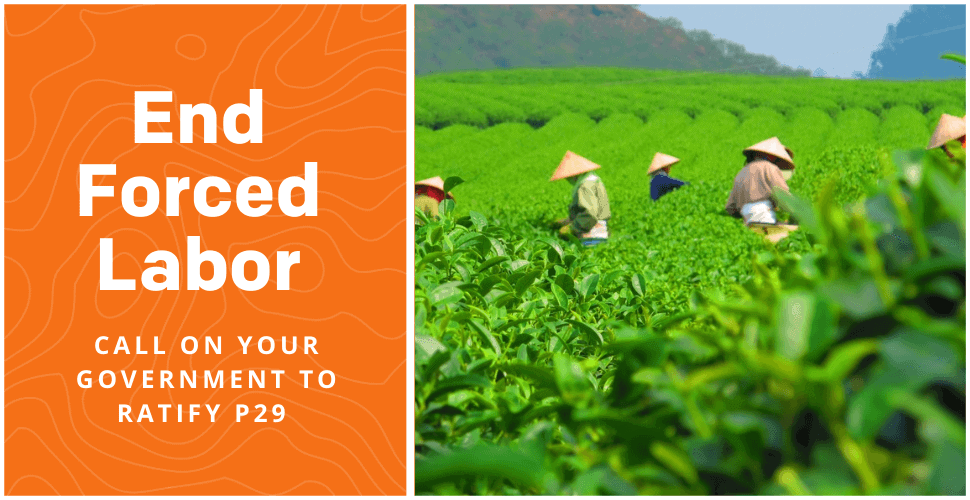International Labour Organization (ILO) Forced Labour Convention 29 (C29) was introduced in 2014 to update the outdated 1930 Forced Labour Convention No. 29.
How did the Forced Labour Protocol come about?
International laws against forced labor have actually existed for more than 90 years. The Forced Labour Convention of the International Labour Organization (C29) was created back in 1930 to protect workers around the world. But according to estimates, more than 40 million people today still live in modern-day slavery. The Convention didn’t achieve its goal. It has outdated language, gaps, and loopholes that allow forced labor to continue to thrive, such as concessions for countries under colonial rule.
That’s why in 2014, the international community decided the Convention needed a revamp and amended it with the Forced Labour Protocol (P29). The Protocol formally deletes over 22 articles of the 33 in the original Convention that are outdated or no longer relevant.
It also addresses issues that were not covered in the original convention, such as protection and compensation for victims and recognizing that the scope of the problem is wider than simply outlawing forced labor. It also includes specific measures calling for the protection and compensation of victims regardless of their legal status in a country.
The Protocol is the current gold standard of international legislation against forced labor. Ratifying it is a crucial step for countries to take towards ending forced labor once and for all.
Success Stories
So far, 43 countries have successfully ratified the Protocol. Over a third of these ratifications have taken place since the start of 2019 alone. This means they have made a legally binding commitment to end forced labor. It also means the international community has the power to monitor progress on anti-slavery legislation and influence its implementation.
Niger was the first country to ratify the Protocol. Since joining in 2015, it has made major strides to tackle the significant problem of forced labor within its borders. The Supreme Court has banned wahaya, a practice by which men buy girls born into slavery as “fifth wives,” and adopted a law to protect internally displaced people from labor exploitation. The government also trained over 300 members of the legal system on prosecuting trafficking cases.
Argentina ratified the Protocol back in 2016. Since the Protocol came into force, the government has made significant advancements against ending forced labor. In 2018, the Secreteriat of Labor published its first national child labor survey, as well as approving a 2018-2020 Action Plan against Human Trafficking and Exploitation. It has also published legal guides for investigators and workers in the justice sector, upholding a major tenet of the Protocol: education.
Thailand became the first Asian country to ratify the Protocol in June 2018. In the time since, it has introduced new legislation to eliminate forced labor in the country, where it is a particular issue in the seafood industry. Forced labor is now officially an offense under the country’s existing anti-trafficking laws, and those found guilty face fines and prison time. In the garment industry, the government has also ordered factories to compensate workers after they were found to be underpaid.
You can read the full list of ratified countries here.
Why do we need international laws against forced labor?
Forced labor takes many forms, but it all comes down to people being forced to work against their will. It exists all across the world and is a hugely profitable international phenomenon, ensnaring millions of people and generating billions of dollars in illegal profits. The world is more connected than ever before, but with great movements of people comes a high risk of exploitation. Today, migrants are among those most vulnerable to exploitation and trafficking, but they are not protected under international law. There is little regulation tackling fraudulent recruitment practices that lure people to cross borders in search of work. Tragically, in many countries, undocumented migrants escape modern slavery only to be criminalized themselves.
Migrants and other high-risk groups, such as internally displaced people, often lack the necessary information to seek help, while employers and legal officials lack the information to recognize forced labor and adequately protect those in need. On both sides, there is insufficient education on the issue of forced labor and human trafficking. This creates opportunities for perpetrators to continue to exploit people unnoticed and unchallenged.
These circumstances endure because governments are not doing enough to tackle forced labor. It is up to governments to create regulations that ensure employers treat workers with dignity. It is up to governments to protect victims and ensure they can get help regardless of their immigration status. It is up to governments to educate employers and members of the legal system on the issue of forced labor. Until governments around the world uphold these standards, there will always be loopholes through which forced labor can thrive.
That’s why it’s important that as citizens we use our voice to call on them to take action. We have the collective ability to push our governments to make a commitment to end this suffering once and for all. That’s where international law comes in: it gives countries legal obligations to take a stand and holds them accountable by the international community. It creates a united front against forced labor and represents a coordinated effort to eliminate it.
It can be easy to hear these stories and feel helpless, but in fact, we have more power than we think if we use our voices to push for change and urge our governments to take action.
What next?
We are thrilled that more countries have ratified the Protocol, but the fight is far from over. Most of the world’s countries still lack the legal commitment and accountability to tackle forced labor inside their borders, leaving their citizens and immigrant populations vulnerable to exploitation.
Photo: Malawi ratifying the Forced Labor Protocol
That’s why it’s imperative that we keep pushing for more countries to ratify. An international issue like forced labor can only be addressed with an international effort. We have to call for our governments to keep forced labor high on their national agenda. We have to push them to take the necessary measures to put a stop to forced labor once and for all.
The Forced Labour Protocol alone may not put an end to forced labor, but it is a key part of the fight. It represents a commitment by governments to tackle forced labor in their countries, and holds them accountable for making progress. It brings countries together to tackle a truly global challenge. The Protocol is a catalyst for change: change towards a world free of modern slavery
Urge your government to take a stand and sign the Forced Labour Protocol.
Add your name to our petition here.










-
Follow us on Facebook
5.6M
-
Follow us on Twitter
32K
-
Follow us on Instagram
8K
-
Subscribe to our Youtube
5.7K
Donate